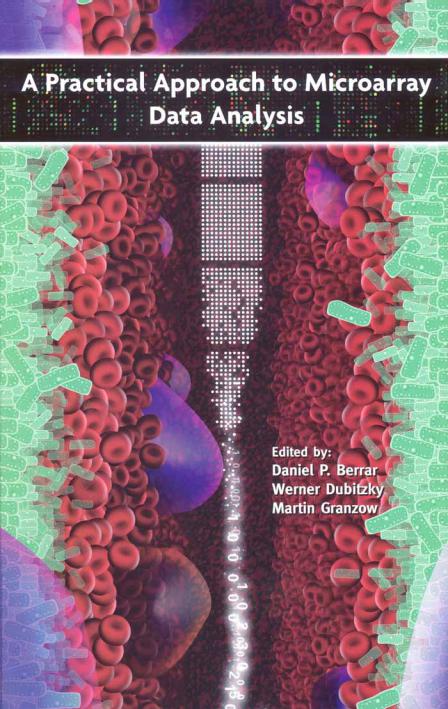
Berrar D. et al. - Practical Approach to Microarray Data Analysis
.pdf

A PRACTICAL APPROACH TO MICROARRAY DATA ANALYSIS
This page intentionally left blank

A PRACTICAL APPROACH TO MICROARRAY DATA ANALYSIS
edited by
Daniel P. Berrar
School of Biomedical Sciences
University of Ulster at Coleraine, Northern Ireland
Werner Dubitzky
Faculty of Life and Health Science
and Faculty of Informatics
University of Ulster at Coleraine, Northern Ireland
Martin Granzow
4T2consulting
Weingarten, Germany
KLUWER ACADEMIC PUBLISHERS
NEW YORK, BOSTON, DORDRECHT, LONDON, MOSCOW
eBook ISBN: |
0-306-47815-3 |
Print ISBN: |
1-4020-7260-0 |
©2003 Kluwer Academic Publishers
New York, Boston, Dordrecht, London, Moscow
Print ©2003 Kluwer Academic Publishers
Dordrecht
All rights reserved
No part of this eBook may be reproduced or transmitted in any form or by any means, electronic, mechanical, recording, or otherwise, without written consent from the Publisher
Created in the United States of America
Visit Kluwer Online at: |
http://kluweronline.com |
and Kluwer's eBookstore at: |
http://ebooks.kluweronline.com |
Contents
Acknowledgements |
vii |
Preface |
ix |
1 Introduction to Microarray Data Analysis |
1 |
Werner Dubitzky, Martin Granzow, C. Stephen Downes, Daniel Berrar |
|
2 Data Pre-Processing Issues in Microarray Analysis |
47 |
Nicholas A. Tinker, Laurian S. Robert, Gail Butler, Linda J. Harris |
|
3 Missing Value Estimation |
65 |
Olga G. Troyanskaya, David Botstein, Russ B. Altman |
|
4 Normalization |
76 |
Norman Morrison and David C. Hoyle |
|
5 Singular Value Decomposition and Principal Component Analysis |
91 |
Michael E. Wall, Andreas Rechtsteiner, Luis M. Rocha |
|
6 Feature Selection in Microarray Analysis |
110 |
Eric P. Xing |
|
7 Introduction to Classification in Microarray Experiments |
132 |
Sandrine Dudoit and Jane Fridlyand |
|
8 Bayesian Network Classifiers for Gene Expression Analysis |
150 |
Byoung-Tak Zhang and Kyu-Baek Hwang |
|
vi |
Contents |
9 Classifying Microarray Data Using Support Vector Machines |
166 |
Sayan Mukherjee |
|
10 Weighted Flexible Compound Covariate Method for Classifying |
|
Microarray Data |
186 |
Yu Shyr and KyungMann Kim |
|
11 Classification of Expression Patterns Using Artificial |
201 |
Neural Networks |
|
Markus Ringnér, Patrik Edén, Peter Johansson |
|
12 Gene Selection and Sample Classification Using a Genetic Algorithm and k-Nearest Neighbor Method 216
Leping Li and Clarice R. Weinberg
13 Clustering Genomic Expression Data: |
230 |
Design and Evaluation Principles |
|
Francisco Azuaje and Nadia Bolshakova |
|
14 Clustering or Automatic Class Discovery: Hierarchical Methods |
246 |
Derek C. Stanford, Douglas B. Clarkson, Antje Hoering |
|
15 Discovering Genomic Expression Patterns with Self-Organizing Neural Networks 261
Francisco Azuaje
16 Clustering or Automatic Class Discovery: |
274 |
non-hierarchical, non-SOM |
|
Ka Yee Yeung |
|
17 Correlation and Association Analysis |
289 |
Simon M. Lin and Kimberly F. Johnson |
|
18 Global Functional Profiling of Gene Expression Data |
306 |
Sorin Draghici and Stephen A. Krawetz |
|
19 Microarray Software Review |
326 |
Yuk Fai Leung, Dennis Shun Chiu Lam, Chi Pui Pang |
|
20 Microrray Analysis as a Process |
345 |
Susan Jensen |
|
Index |
361 |
Acknowledgements
The editors would like to thank the contributing authors for their excellent work. Furthermore, the editors would like to thank Joanne Tracy and Dianne Wuori from Kluwer Academic Publishers for their help and support in editing this volume.
This page intentionally left blank
Preface
In the past several years, DNA microarray technology has attracted tremendous interest in both the scientific community and in industry. With its ability to simultaneously measure the activity and interactions of thousands of genes, this modern technology promises unprecedented new insights into mechanisms of living systems. Currently, the primary applications of microarrays include gene discovery, disease diagnosis and prognosis, drug discovery (pharmacogenomics), and toxicological research (toxicogenomics).
Typical scientific tasks addressed by microarray experiments include the identification of coexpressed genes, discovery of sample or gene groups with similar expression patterns, identification of genes whose expression patterns are highly differentiating with respect to a set of discerned biological entities (e.g., tumor types), and the study of gene activity patterns under various stress conditions (e.g., chemical treatment). More recently, the discovery, modeling, and simulation of regulatory gene networks, and the mapping of expression data to metabolic pathways and chromosome locations have been added to the list of scientific tasks that are being tackled by microarray technology.
Each scientific task corresponds to one or more so-called data analysis tasks. Different types of scientific questions require different sets of data analytical techniques. Broadly speaking, there are two classes of elementary data analysis tasks, predictive modeling and pattern-detection. Predictive modeling tasks are concerned with learning a classification or estimation function, whereas pattern-detection methods screen the available data for interesting, previously unknown regularities or relationships.
A plethora of sophisticated methods and tools have been developed to address these tasks. However, each of these methods is characterized by a set of idiosyncratic requirements in terms of data pre-processing, parameter configuration, and result evaluation and interpretation. To optimally design and analyze microarray experiments, researchers and developers need a
